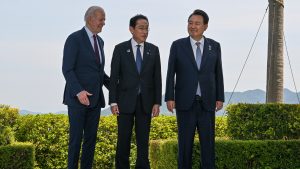
I posted recently here at Alan’s Newsletter on the upcoming BRICS Summit – Puzzling over a BRICS Enlargement. And BRICS, as I described in the Post, is a ‘big deal’ in the pantheon of Leaders’ Summits. I also noted the possible ‘reignition’ of the Trilateral Summit – China, Japan and the Republic of Korea (Korea). But this is not the current extent of summit activity. There is, in fact, another Trilateral Summit that is about to gather – what I am referring to as a ‘Second Trilateral Summit’. This is the gathering at Camp David of the leaders of Japan, Korea and the United States. And since that gathering is tomorrow, Friday, I thought I’d get this Post out in anticipation of the Camp David Trilateral Summit of the three leaders.
‘Global summitry’ – the extent, importance and consequence of these leaders’ gatherings and the global governance progress achieved at these gatherings is, not surprisingly, at the heart of the Global Summitry Project (GSP). It is here in the e-journal Global Summitry, in our work with colleagues in the China-West Dialogue (CWD), and the strengthening of the Sustainable Development Goals (SDGs), and our work with students and researchers through the GSP including the articles, podcasts and videos.
Well let’s turn back, for just a moment to the upcoming Summit. What, you say, a second trilateral summit? Well, yes, actually. The JapanTimes sets out possible goals for such a Trilateral Leaders’ gathering – the Second Trilateral Summit :
In a major step toward making trilateral cooperation a more permanent fixture, U.S.President Joe Biden, Japanese Prime Minister Fumio Kishida and South Korean leader Yoon Suk-yeol will agree to hold three-way summits at least once a year, while also conducting more frequent joint military drills around the Korean Peninsula and bolstering intelligence-sharing, including real-time warning data on North Korean missile launches.
The three leaders are also expected to signal deeper cooperation in areas such as cybersecurity, supply chain resilience and fighting economic coercion.
The one-day meeting — the three leaders’ first stand alone summit not held on the sidelines of a separate event — will take place against the backdrop of North Korea’s ever-improving nuclear and missile programs as well as China’s growing military assertiveness. Both issues will be high on the agenda.
But first and foremost, the summit is expected to focus on laying the foundation for a more durable trilateral relationship that can withstand political change, namely the growing partnership between two of the most powerful democracies in Asia.
What the excerpt from the JapanTimes alludes to is the state of relations between Korea and Japan. Following a history of difficult relations arising initially from Japan’s colonization of Korea and then actions in Korea by the Japanese military during World War Two, relations between the two have followed an ‘up and down path’ that have precluded consistently close relations.
In an article in Foreign Affairs, Andrew Yeo, Mireya Solis and Hanna Foreman pinpointed the opportunity that President Biden appears to see in this trilateral gathering at Camp David:
Today, however, the stars have aligned at the regional and domestic levels and the Biden administration is therefore looking to solidify trilateral cooperation while there is still momentum.
It would appear that the Biden administration hopes to solidify and, maybe somewhat optimistically, from the Administration’s perspective, to institutionalize this trilateral relationship:
One possibility is holding a leaders summit annually, or at least formalizing trilateral meetings for national security advisers, which have taken place annually the past three years but on an ad hoc basis. Trilateral cooperation might also be routinized at the deputy or working levels on specific issues such as economic security, energy cooperation, and climate. Institutionalization would help preserve trilateral cooperation even in the face of domestic political change or deterioration in Japanese–South Korean relations.
This current trilateral effort plays to the Biden administration effort to strengthen alliances and partnerships in the face of growing strategic US-China competition. And, as such, it fails to promote in the Indo-Pacific region the cross-cutting relations that we identified in the earlier Substack Post “Advancing global governance and revitalizing a regional institution”, the First Trilateral Summit – China, Korea and Japan.
But what none of the current summit examinations have targeted is an assessment of the global governance progress, whether debt management, climate action, financing development, nuclear safety, AI and digital governance and a host of other goals. So, the pace of leaders’ summits appears to be quickening but we do need to examine their consequences.
So, let me at least raise in this Post, what I believe is the ‘continuum of action and commitment’ available to leaders in these various Leaders’ Summits. This continuum identifies the extent to which global governance policies have been secured. We move from the aspirational, often set out in the leaders’ declarations or communiques all the way to implementation by a country. What is evident from the continuum is that these folks are governmental leaders. And, as a result no matter what the communique announces, individual leaders’ may, or may not, actually implement a collective wish set out in a declaration. This is well beyond just the aspirational.
The continuum, as I see it, is: Consultation/ Cooperation/ Coordination/ Collaboration – the 4Cs of global governance progress, as I see it. Distinguishing between these concepts can be quite difficult. And of course, beyond this is, collectively achieving the actions, proposals and policies that are set out in the communiques, or announced at the Leaders’ gatherings.
Let me return to the 4Cs in an upcoming Post. But do keep this continuum in mind when thinking about leaders’ announcements or declarations. We will be hearing them, or reading about them, shortly, in upcoming announcements and communiques.
This Rising BRICSAM post first was posted to my Substack, Alan’s Newsletter https://globalsummitryproject.substack.com/p/not-simply-the-pace-of-summitry?utm_source=profile&utm_medium=reader2
Feel free to comment on it and to subscribe to my Substack
Image Credit: NY Times

